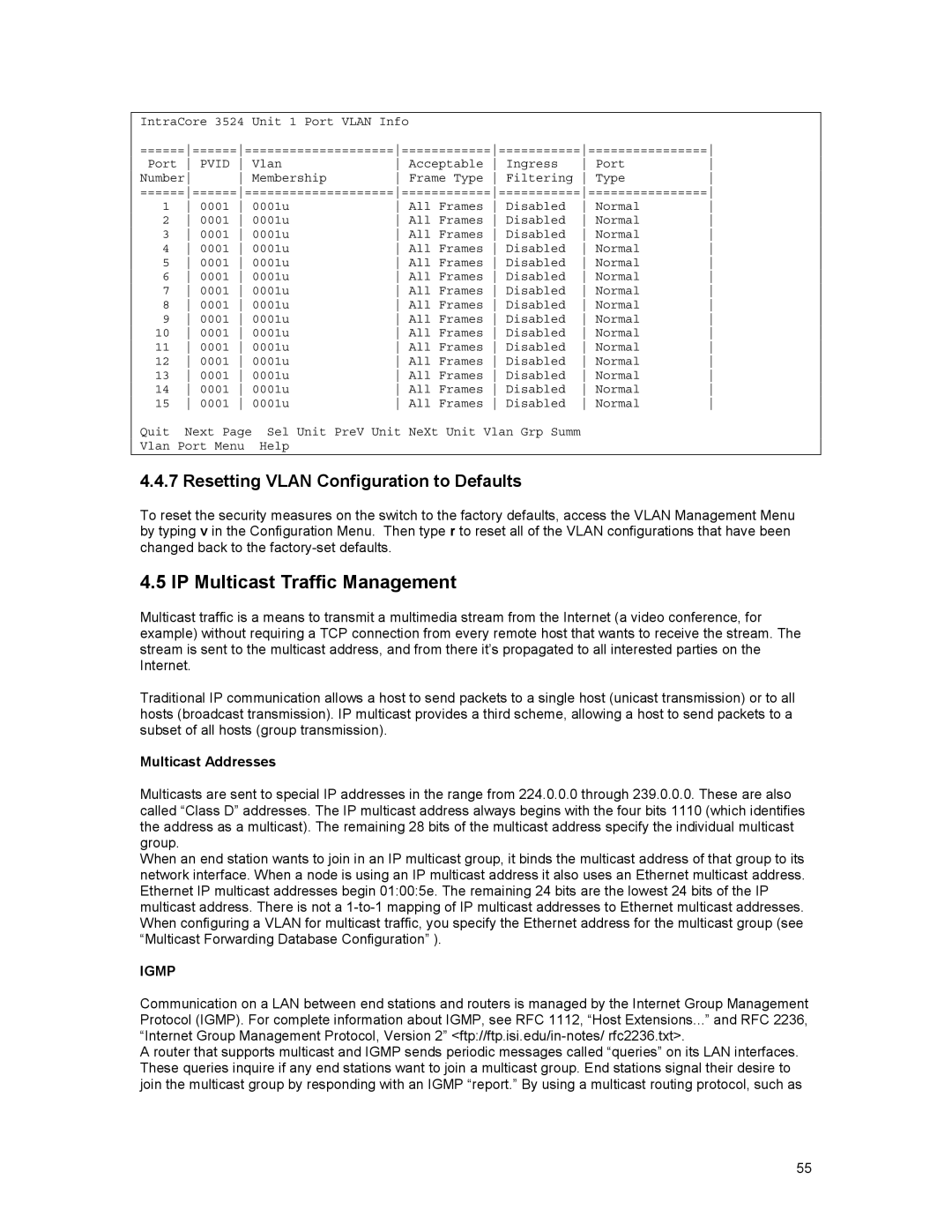
IntraCore 3524 Unit 1 Port VLAN Info
=======================================================================
Port | PVID | Vlan | Acceptable | Ingress | Port | |||
Number | Membership | Frame Type | Filtering | Type |
=======================================================================
1 | 0001 0001u | All Frames Disabled | Normal | ||
2 | 0001 0001u | All Frames Disabled | Normal | ||
3 | 0001 0001u | All Frames Disabled | Normal | ||
4 | 0001 0001u | All Frames Disabled | Normal | ||
5 | 0001 0001u | All Frames Disabled | Normal | ||
6 | 0001 0001u | All Frames Disabled | Normal | ||
7 | 0001 0001u | All Frames Disabled | Normal | ||
8 | 0001 0001u | All Frames Disabled | Normal | ||
9 | 0001 0001u | All Frames Disabled | Normal | ||
10 | 0001 0001u | All Frames Disabled | Normal | ||
11 | 0001 0001u | All Frames Disabled | Normal | ||
12 | 0001 | 0001u | All Frames Disabled | Normal | |
13 | 0001 | 0001u | All Frames Disabled | Normal | |
14 | 0001 | 0001u | All Frames Disabled | Normal | |
15 | 0001 | 0001u | All Frames Disabled | Normal | |
Quit Next Page Sel Unit PreV Unit NeXt Unit Vlan Grp Summ
Vlan Port Menu Help
4.4.7 Resetting VLAN Configuration to Defaults
To reset the security measures on the switch to the factory defaults, access the VLAN Management Menu by typing v in the Configuration Menu. Then type r to reset all of the VLAN configurations that have been changed back to the
4.5 IP Multicast Traffic Management
Multicast traffic is a means to transmit a multimedia stream from the Internet (a video conference, for example) without requiring a TCP connection from every remote host that wants to receive the stream. The stream is sent to the multicast address, and from there it’s propagated to all interested parties on the Internet.
Traditional IP communication allows a host to send packets to a single host (unicast transmission) or to all hosts (broadcast transmission). IP multicast provides a third scheme, allowing a host to send packets to a subset of all hosts (group transmission).
Multicast Addresses
Multicasts are sent to special IP addresses in the range from 224.0.0.0 through 239.0.0.0. These are also called “Class D” addresses. The IP multicast address always begins with the four bits 1110 (which identifies the address as a multicast). The remaining 28 bits of the multicast address specify the individual multicast group.
When an end station wants to join in an IP multicast group, it binds the multicast address of that group to its network interface. When a node is using an IP multicast address it also uses an Ethernet multicast address. Ethernet IP multicast addresses begin 01:00:5e. The remaining 24 bits are the lowest 24 bits of the IP multicast address. There is not a
IGMP
Communication on a LAN between end stations and routers is managed by the Internet Group Management Protocol (IGMP). For complete information about IGMP, see RFC 1112, “Host Extensions...” and RFC 2236, “Internet Group Management Protocol, Version 2”
A router that supports multicast and IGMP sends periodic messages called “queries” on its LAN interfaces. These queries inquire if any end stations want to join a multicast group. End stations signal their desire to join the multicast group by responding with an IGMP “report.” By using a multicast routing protocol, such as
55
